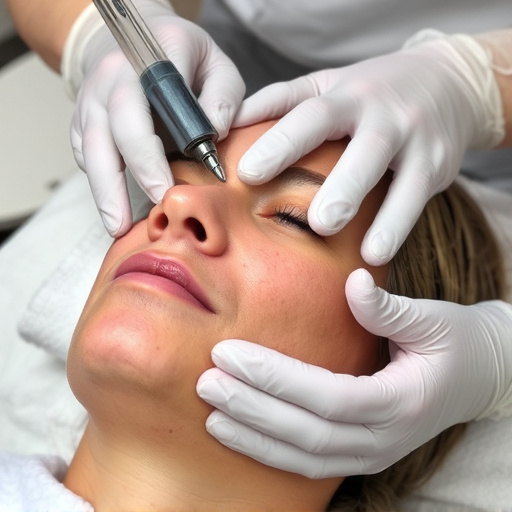Cystic Acne Treatment for Darker Skin: Expert Strategies for Clearer Skin
Cystic acne, a common yet challenging condition for individuals with darker skin tones, can be effec…….
Cystic acne, a severe form of acne vulgaris, presents as painful, deep-seated cysts on the skin, particularly affecting the face, neck, and upper body. As a prevalent skin condition worldwide, it impacts individuals across various demographics, leading to significant psychological and social repercussions. This article aims to delve into the multifaceted world of cystic acne treatment, exploring historical approaches, current trends, technological innovations, regulatory frameworks, and future prospects. By examining these aspects, we can gain insights into the comprehensive strategies employed in managing this complex dermatological challenge.
Cystic acne treatment involves a multi-faceted approach aimed at addressing the underlying causes of this debilitating skin condition. It encompasses a combination of medical interventions, lifestyle modifications, and topical therapies. The primary goal is to reduce inflammation, prevent scarring, and restore clear skin. Historically, treatments have evolved from topical remedies to more advanced procedures, reflecting the growing understanding of acne pathophysiology.
Core Components:
Topical Therapies: These include over-the-counter (OTC) medications such as benzoyl peroxide, salicylic acid, and retinoids, which are applied directly to the skin. Prescription-strength options offer stronger formulations for more severe cases.
Oral Medications: Antibiotics like tetracycline and doxycycline are often prescribed to combat bacterial infections associated with acne. Isotretinoin, a derivative of vitamin A, is a powerful oral medication reserved for severe cystic acne due to its potential teratogenic effects.
Hormonal Treatments: For hormonally-driven acne, hormonal pills like birth control pills or spironolactone may be prescribed to regulate hormone levels and reduce skin inflammation.
Procedural Interventions: This category includes various medical procedures such as extraction (popping or squeezing cysts under sterile conditions), dermabrasion, chemical peels, and laser treatments. These methods aim to physically remove acne lesions or improve skin texture.
Lifestyle Modifications: Educating patients about lifestyle changes is crucial. These include maintaining a balanced diet, managing stress, improving sleeping habits, and practicing good skincare hygiene.
Cystic acne is not confined to any particular region, affecting individuals across diverse cultures and socio-economic backgrounds. However, certain trends emerge when examining its global impact:
| Region | Prevalence Rate (%) | Notable Considerations |
|---|---|---|
| North America | 5-10% of adolescents and young adults | High accessibility to advanced treatments, but also higher rates of medication-related side effects. |
| Europe | Prevalence varies by country, with up to 20% in some populations | Regional differences in treatment preferences, with a growing adoption of innovative therapies. |
| Asia Pacific | Significant regional variations, with urban areas showing higher rates | Rapidly evolving skincare industry, but limited access to specialized treatments in rural regions. |
| Middle East and Africa | Prevalence increases in urban centers due to changing lifestyles | Growing awareness and investment in dermatological care, yet challenges remain in remote areas. |
The global acne market, driven by the rising prevalence of cystic acne, is experiencing significant growth. According to a 2021 report by Grand View Research, this market size was valued at USD 3.4 billion in 2020 and is expected to grow at a compound annual growth rate (CAGR) of 7.8% from 2021 to 2028. This trend highlights the increasing demand for effective treatments and the significant economic impact of cystic acne.
The economic implications of cystic acne treatment are multifaceted, encompassing market trends, healthcare spending, and investment opportunities.
Market Dynamics:
Investment Patterns:
Technology has played a pivotal role in enhancing cystic acne treatment options, improving patient outcomes, and increasing accessibility.
Breakthrough Technologies:
Laser Therapy: Fractional laser treatments, such as Fraxel and 1064 nm Nd:YAG lasers, offer precise targeting of skin tissue, stimulating collagen production and improving skin texture. These non-invasive procedures have gained popularity due to their ability to treat cystic acne scars effectively.
Intra-lesional Injections: Steroid injections directly into cysts can reduce inflammation and shrink lesions quickly. This technique is particularly useful for managing large, painful cysts, but it requires careful monitoring to prevent potential side effects.
Minimally Invasive Procedures: Microneedling and radiofrequency (RF) treatments are emerging as less invasive alternatives to surgical procedures. These methods promote collagen stimulation and skin rejuvenation without the associated risks of more aggressive interventions.
Digital Tools and Telemedicine: Mobile apps and digital platforms provide patient monitoring, personalized treatment plans, and remote consultations. These tools improve patient engagement and enable healthcare providers to offer tailored care, especially in regions with limited access to dermatologists.
The regulatory environment surrounding cystic acne treatments varies across jurisdictions, impacting product availability, pricing, and patient access.
Key Considerations:
Despite significant advancements, cystic acne treatment faces several challenges that hinder its effectiveness and accessibility.
Key Issues:
Cost and Accessibility: The high cost of advanced treatments, such as lasers and specialized medications, limits access for many patients, particularly those in underserved communities or developing nations.
Side Effects: Some treatments carry potential side effects, including skin irritation, hyperpigmentation, and teratogenic risks associated with certain medications. Balancing the benefits against these risks is a continuous challenge.
Individualized Treatment Plans: Cystic acne is a highly individualized condition, making it challenging to develop one-size-fits-all treatment strategies. Personalized approaches that consider genetic predispositions, lifestyle factors, and skin responsiveness are essential for optimal outcomes.
Patient Education and Adherence: Ensuring patient understanding of their treatment plans and promoting adherence to prescribed regimens can be difficult. Many patients struggle with consistent skincare routines or fail to recognize the importance of lifelong management.
Proposed Solutions:
A 24-year-old female patient presented with severe cystic acne, genetically predisposed to the condition due to a known mutation in the PPARγ gene. Standard topical treatments had proven ineffective. The healthcare team developed a targeted approach combining a super-potent retinoid with a novel delivery system that enhanced skin penetration. Additionally, they prescribed a low-dose, localized steroid injection for acute cyst management.
Outcomes: After 12 weeks, the patient’s acne severity reduced by 75%, and most cysts had resolved. The personalized treatment plan highlighted the importance of genetic considerations in cystic acne management, offering a more effective and targeted approach.
A 19-year-old male patient suffered from severe cystic acne during adolescence, leaving him with prominent atrophic scars. He sought treatment to improve his skin appearance for social and professional interactions. The dermatological team recommended a combination of Fraxel laser therapy and microneedling.
Outcomes: Following the treatment series, the patient’s skin showed significant improvements in scar reduction and texture enhancement. He reported increased confidence and a positive impact on his social life, demonstrating the transformative power of advanced procedural interventions.
The landscape of cystic acne treatment is continually evolving, driven by technological advancements, shifting consumer preferences, and growing clinical insights.
Emerging Trends:
Strategic Considerations for Stakeholders:
Cystic acne treatment represents a complex interplay of medical science, technology, policy, and patient advocacy. As our understanding of this condition deepens, so too does our ability to offer effective solutions. From historical topical remedies to cutting-edge technological advancements, the journey toward clear skin for those affected by cystic acne continues to evolve.
By addressing economic considerations, embracing technological breakthroughs, navigating regulatory challenges, and learning from case studies, we can forge a path toward improved patient outcomes. The future of cystic acne treatment promises personalized, accessible, and transformative care, empowering individuals to reclaim their confidence and self-esteem. As research progresses and digital health tools become more sophisticated, the global impact of cystic acne will be addressed with renewed vigor, offering hope for clearer, healthier skin worldwide.
Q: How can I determine if my acne is cystic?
A: Cystic acne is characterized by deep-seated lesions that form beneath the skin’s surface. These cysts are often painful and can leave scars. If you suspect you have cystic acne, consult a dermatologist who can diagnose it accurately through visual examination and sometimes, skin biopsies.
Q: Are there any home remedies for cystic acne?
A: While some people may find relief from mild acne with over-the-counter products, cystic acne generally requires professional medical intervention. Home remedies alone are typically ineffective against this severe form of acne. However, maintaining a healthy lifestyle, including proper diet and stress management, can support overall skin health.
Q: Can antibiotics help with cystic acne?
A: Yes, antibiotics are commonly prescribed to treat cystic acne, especially for bacterial infections associated with the condition. Oral medications like tetracycline and doxycycline are often used, but it’s important to complete the full course as directed by your healthcare provider to ensure optimal results.
Q: Are laser treatments painful?
A: Laser therapy for cystic acne is generally well-tolerated, and pain levels vary depending on the specific treatment and individual sensitivity. Modern lasers are designed with patient comfort in mind, and topical anesthetics can be applied beforehand to minimize discomfort.
Q: Can cystic acne leave permanent scars?
A: Yes, cystic acne can indeed lead to permanent scarring, including atrophic (depressed) scars and keloid formation. Timely and appropriate treatment is crucial to minimize scarring. Advanced procedures like laser therapy and microneedling can help improve scar appearance, but complete elimination of scars is often not possible.

Cystic acne, a common yet challenging condition for individuals with darker skin tones, can be effec…….

Cystic acne, caused by hormonal imbalances, genetics, and excess sebum, needs customized treatment……..

Cystic acne treatment requires a dedicated, multifaceted approach with no quick fixes. Professional…….